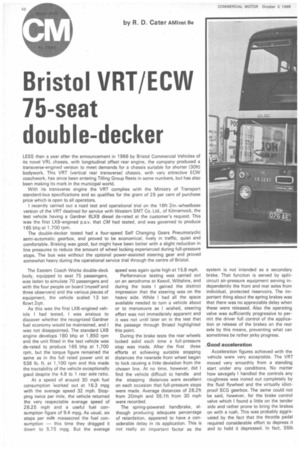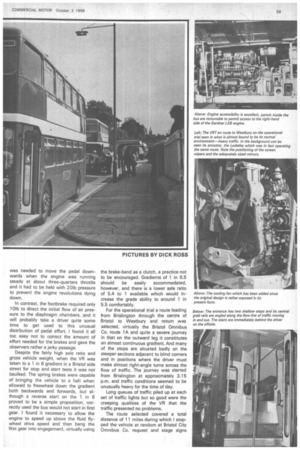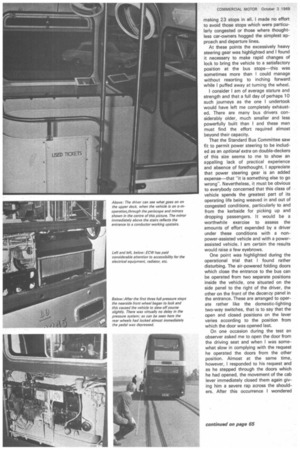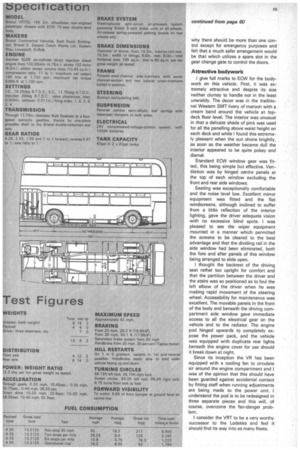Bristol VRT/ECW 75-seat double-decker
Page 64

Page 65

Page 66

Page 71

If you've noticed an error in this article please click here to report it so we can fix it.
LESS than a year after the announcement in 1966 by Bristol Commercial Vehicles of its novel VRL chassis, with longitudinal offset rear engine, the company produced a transverse-engined version to meet demands for a chassis suitable for shorter (30ft) bodywork. This VRT (vertical rear transverse) chassis, with very attractive ECW coachwork, has since been entering Tilling Group fleets in some numbers, but has also been making its mark in the municipal world.
With its transverse engine the VRT complies with the Ministry of Transport standard-bus specifications and so qualifies for the grant of 25 per cent of purchase price which is open to all operators.
I recently carried out a road test and operational trial on the 16ft 2in.-wheelbase version of the VRT destined for service with Western SMT Co. Ltd., of Kilmarnock, the test vehicle having a Gardner 6LXB diesel de-rated at the customer's request. This was the first LXB-engined p.s.v. that CM had tested, and was governed to produce 165 bhp at 1,700 rpm.
The double-decker tested had a four-speed Self Changing Gears Pneumocyclic semi-automatic gearbox, and proved to be economical, lively in traffic, quiet and comfortable. Braking was good, but might have been better with a slight reduction in line pressures to reduce the amount of wheel locking experienced during full-pressure stops. The bus was without the optional power-assisted steering gear and proved somewhat heavy during the operational service trial through the centre of Bristol.
The Eastern Coach Works double-deck body, equipped to seat 75 passengers, was laden to simulate 70 passengers and with the four people on board (myself and three observers) and the various pieces of equipment, the vehicle scaled 13 ton 6cwt 2qtr.
As this was the first LXB-engined vehicle I had tested, I was anxious to discover whether the recognized Gardner fuel economy would be maintained, and I was not disappointed. The standard LXI3 engine develops 180 bhp at 1,850 rpm and the unit fitted in the test vehicle was de-rated to produce 165 bhp at 1,700 rpm, but the torque figure remained the same as in the full rated power unit at 536 lb. ft. at 1,100 rpm and this made the tractability of the vehicle exceptionally good despite the 4.9 to 1 rear axle ratio.
At a speed of around 30 mph fuel consumption Worked out at 16.3 mpg with the average speed 32 mph. Stopping twice per mile, the vehicle returned the very respectable average speed of 26.25 mph and a useful fuel consumption figure of 9.4 mpg. As usual, six stops per mile massacred the fuel consumption — this time they dragged it down to 5.75 mpg. But the average speed was again quite high at 15.8 mph.
Performance testing was carried out on an aerodrome at Keevil, Wiltshire, and during the tests I gained the distinct impression that the steering was on the heavy side. While I had all the space available needed to turn a vehicle about or to manoeuvre as I wished, steering effort was not immediately apparent and it was not until later on in the test that the passage through Bristol highlighted this point.
During the brake tests the rear wheels locked solid each time a full-pressure stop was made. After the first three efforts at achieving suitable stopping distances the nearside front wheel began to lock causing a little deviation from the chosen line. At no time, however, did I find the vehicle difficult to handle and the stopping distances were excellent on each occasion that full-pressure stops were made. Average distances of 26.2ft from 20mph and 55.1ft from 30 mph were recorded.
The spring-powered handbrake, although producing adequate percentage of retardation, appeared to have a considerable delay in its application. This is not really an important factor as the system is not intended as a secondary brake. That function is served by splitcircuit air-pressure equipment serving independently the front and rear axles from individual, protected reservoirs. The important thing about the spring brakes was that there was no appreciable delay when these were released. Also the operating valve was sufficiently progressive to permit the driver full control of the application or release of the brakes on the rear axle by this means, preventing what can sometimes be rather jerky progress.
Good acceleration
Acceleration figures achieved with the vehicle were very acceptable. The VRT moved very smoothly from a standing start under any conditions. No matter how savagely I handled the controls any roughness was ironed out completely by the fluid flywheel and the virtually idiotproof SCG gearbox. The same could not be said, however, for the brake control valve which I found a little on the tender side and rather prone to bring the brakes on with a rush. This was probably aggravated by the fact that the throttle pedal required considerable effort to depress it and to hold it depressed. In fact, 55Ib was needed to move the pedal downwards when the engine was running steady at about three-quarters throttle and it had to be held with 20Ib pressure to prevent the engine revolutions dying down.
In contrast, the footbrake required only 10Ib to direct the initial flow of air pressure to the diaphragm chambers, and it will probably take a driver quite some time to get used to this unusual distribution of pedal effort. I found it all too easy not to correct the amount of effort needed for the brakes and gave the observers rather a jerky passage.
Despite the fairly high axle ratio and gross vehicle weight, when the VR was taken to a 1 in 6 gradient in a Bristol side street for stop and start tests it was not baulked. The spring brakes were capable of bringing the vehicle to a halt when allowed to freewheel down the gradient both backwards and forwards, but although a reverse start on the 1 in 6 proved to be a simple proposition, correctly used the bus would not start in first gear. I found it necessary to allow the engine to speed up above the fluid flywheel drive speed and then bang the first gear into engagement, virtually using the brake-band as a clutch, a practice not to be encouraged. Gradients of 1 in 6.5 should be easily accommodated, however, and there is a lower axle ratio of 5.4 to 1 available which would increase the grade ability to around 1 in 5.5 comfortably.
For the operational trial a route leading from Brislington through the centre of Bristol to Westbury and return was selected, virtually the Bristol Omnibus Co. route 1A and quite a severe journey in that on the outward leg it constitutes an almost continuous gradient. And many of the stops are situated badly on the steeper sections adjacent to blind corners and in positions where the driver must make almost right-angle turns across the flow of traffic. The journey was started from Brislington at approximately 3.15 p.m. and traffic conditions seemed to be unusually heavy for the time of day.
Long queues of traffic piled up at each set of traffic lights but so good were the creeping qualities of the VR that the traffic presented no problems.
The route selected covered a total distance of 11 miles during which I stopped the vehicle at random at Bristol City Omnibus Co. request and stage signs making 23 stops in all. I made no effort to avoid those stops which were particularly congested or those where thoughtless car-owners hogged the simplest approach and departure lines.
At these points the excessively heavy steering gear was highlighted and I found it necessary to make rapid changes of lock to bring the vehicle to a satisfactory position at the bus stops—this was sometimes more than I could manage without resorting to inching forward while I puffed away at turning the wheel.
I consider I am of average stature and strength and that a full day of perhaps 10 such journeys as the one I undertook would have left me completely exhausted. There are many bus drivers considerably older, much smaller and less powerfully built than I and these men must find the effort required almost beyond their capacity.
That the Standard Bus Committee saw fit to permit power steering to be included as an optional extra on double-deckers of this size seems to me to show an appalling lack of practical experience and absence of forethought. I appreciate that power steering gear is an added expense—that "it is something else to go wrong". Nevertheless, it must be obvious to everybody concerned that this class of vehicle spends the greatest part of its operating life being weaved in and out of congested conditions, particularly to and from the kerbside for picking up and dropping passengers. It would be a worthwhile exercise to assess the amounts of effort expended by a driver under these conditions with a nonpower-assisted vehicle and with a powerassisted vehicle. I am certain the results would raise a few eyebrows.
One point was highlighted during the operational trial that I found rather disturbing. The air-powered folding doors which close the entrance to the bus can be operated from two separate positions inside the vehicle, one situated on the side panel to the right of the driver, the other on the front of the decency panel in the entrance. These are arranged to operate rather like the domestic-lighting two-way switches, that is to say that the open and closed positions on the lever varies according to the position from which the door was opened last.
On one occasion during the test an observer asked me to open the door from the driving seat and when I was somewhat slow in complying with the request he operated the doors from the other position. Almost at the same time, however, I responded to his request and as he stepped through the doors which he had opened, the movement of the cab lever immediately closed them again giving him a severe rap across the shoulders. After this occurrence I wondered why there should be more than one control except for emergency purposes and felt that a much safer arrangement would be that which utilizes a spare slot in the gear change gate to control the doors. •
Attractive bodywork
I give full marks to ECW for the bodywork on this vehicle. First, it was extremely attractive and despite its size neither clumsy to handle nor in the least unwieldy. The decor was in the traditional Western SMT livery of maroon with a cream band around the vehicle at topdeck floor level. The interior was unusual in that a delicate shade of pink was used for all the panelling above waist height on each deck and while I found this extremely pleasant when the sun shone brightly, as soon as the weather became dull the interior appeared to be quite pokey and dismal.
Standard ECW window gear was fitted, this being simple but effective. Ventilation was by hinged centre panels at the top of each window excluding the front and rear side windows.
Seating was exceptionally comfortable and the noise level low. Excellent mirror equipment was fitted and the flat windscreens, although inclined to suffer from a little reflection of the interior lighting, gave the driver adequate vision with no excessive blind spots. I was pleased to see the wiper equipment mounted in a manner which permitted the screens to be cleared to the best advantage and that the dividing rail in the side window had been eliminated, both the fore and after panels of this window being arranged to slide open.
I thought the backrest of the driving seat rather too upright for comfort and that the partition between the driver and the stairs was so positioned as to foul the left elbow of the driver when he was making rapid movement of the steering wheel. Accessibility for maintenance was excellent. The movable panels in the front of the body and beneath the driving compartment side window gave immediate access to all the electrical gear on the vehicle and to the radiator. The engine pod hinged upwards to completely expose the power pack, and the vehicle was equipped with duplicate rear lights beneath the engine cover for use should it break down at night.
Since its inception the VR has been equipped with a cooling fan to circulate air around the engine compartment and I was of the opinion that this should have been guarded against accidental contact by fitting staff when running adjustments are being made to the power unit. I understand the pod is to be redesigned in three separate pieces and this will, of course, overcome the fan-danger problem.
I consider the VRT to be a very worthy successor to the Lodekka and feel it should find its way into as many fleets.




































































































































